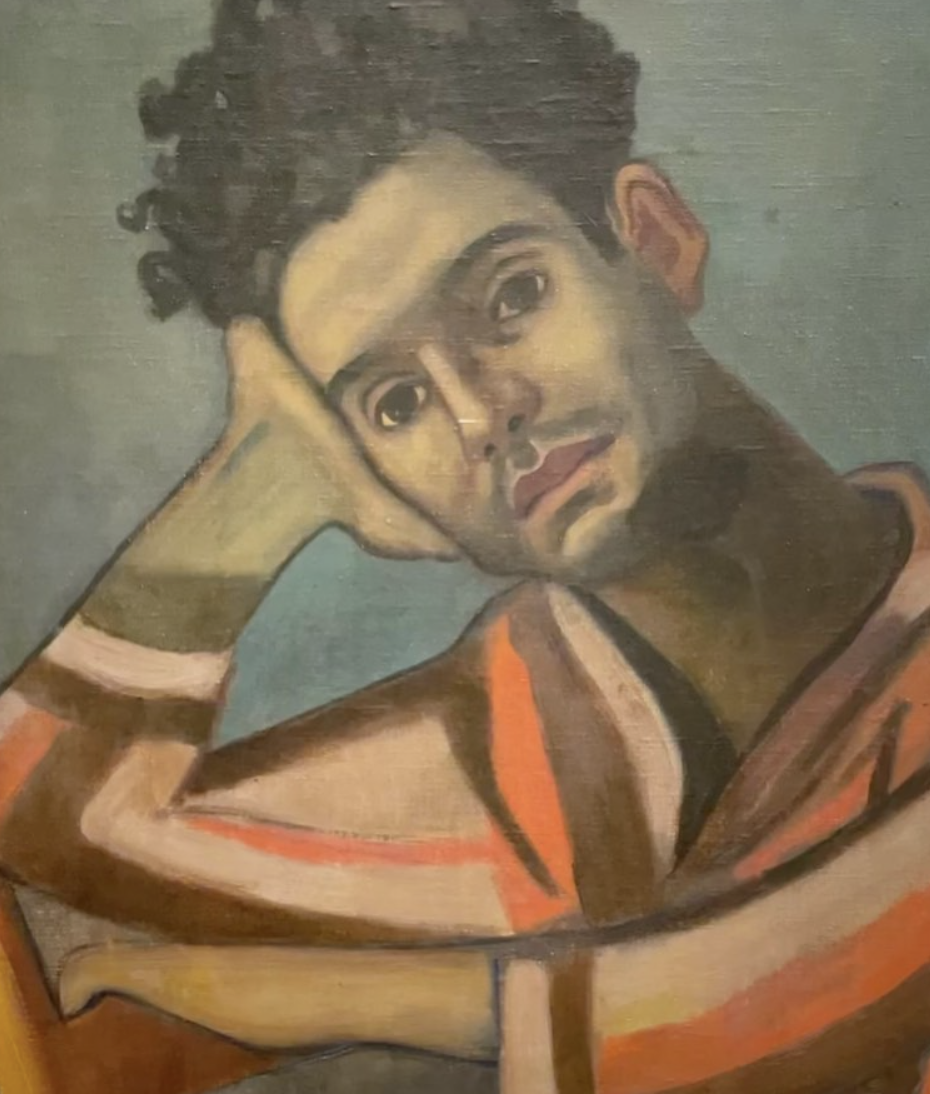James Weeks is not a name that will immediately bring an image to mind for most people. Yet his painting, though quite different, and more formal than Park, Bischoff and Diebenkorn has a very contemporary look. His role in Bay Area Figuration is less known.
Weeks had been a billboard sign painter. He became a colleague of theirs teaching at the San Francisco Art Institute. He had destroyed all his figurative work in 1957 and begun over.
Weeks frequented jazz clubs and boxing rings. He was not just painting his own world and I was surprised that more has not been written about this white man, who, like Alice Neel, was unafraid of depicting people of color--though they were more part of her immediate world.
There are geometries and brighter, even harsher colors than the others in the group utilized , but the focus is on the posed, almost stilted, photographic, Fighter and Manager, from 1960. Weeks is often singled out from the others for his 'plain style'. He did paint landscapes—as noted by his granddaughter. He had been strongly influenced by the Mexican muralists and imparted a layer of social concern to the movement, which to my eye, seems to bring us right up to the present.
The Inside World of Alice Neel
Though I had seen many images from the Alice Neel show at the Met, I was not prepared for the breadth and depth of the actual exhibition. Fair warning: even with a ticket, in mid week, in the morning, the line was at least 30-45 minutes to enter. It is beyond worth it.
The exhibition provokes questions about her biography. If you go to aliceneel.com, you will be able to see marvelous photographs of her and her world and also learn the more granular details.
Though we are often warned not to conflate the life and the work, with Neel, it's impossible not to be struck by the number of marriages she tore apart, and the number of relationships of her own that seemed fungible. Neel felt free to pursue her passions, be they artistic or romantic. Some blew up on her. Her relationship with Carlos Enriquez ended in abandonment along with the death of one daughter and the hijacking of another and her subsequent hospitalization for a nervous breakdown. Hot tempered seaman Kenneth Doolittle burned and destroyed a large archive of her art. John Rothschild left his wife for her, but she did not commit to him. Perhaps he reminded her too much of her more conventional Pennsylvania background. Jose Negron, a salsa band leader, pictured here in 1936, left his wife for Neel but interestingly, she ended up using her as a subject.
Not long after they got together, they moved to Spanish Harlem and she began the prolific, clear eyed rendering of her friends and neighbors that is such an important part of the exhibition. They had a child, Richard, together (originally called Neel!) but Negron moved on a few years later to another woman.
The libertinage of the age went along with the politics, and the artistic milieu. Inevitably, there was collateral damage. But at the Met, we see the affection she once bore for her lovers in her indelible portraits. West coasters take heart: the show comes to the deYoung in 2022.
Jose1936, Estate of Alice Neel
Alice Neel's Two Girls
When I saw this 1954 image in the Hilton Als curated show of Alice Neel's work at David Zwirner in 2017 I could not get it out of my mind. Everything about my childhood in the first northern city to have court ordered integration, New Rochelle, came rushing back to me, though truth be told it has never been far away. The indelible images I have of my friend Eddie--still my friend--the lone black boy who was deposited by a big yellow school bus in our class along with just five other students into different classrooms cannot ever be erased. We all were the experiment--and the suit brought by the brave black parents who merely wanted the same things my parents could access went all the way to the Supreme Court via Thurgood Marshall and a lesser known, but heroic attorney, Paul Zuber.
Alice Neel was a pioneer. She lived among black residents in East Harlem. Als says in the catalog, "Neel was a painter of modern life and part of her genius was based on her knowledge and embrace of the fact that New York was not a homogenous place; she knew there were many different kinds of stories to tell...".
As we navigate these perilous times, both in terms of Black Lives Matter and the disparity in wealth and circumstance affecting us all, we would do well to remember that this is not the first time this battle has been fought and redouble our efforts to understand how we could be living so near to each other and yet so far in circumstance. . Neel's art--and other excellent art being produced now--and indeed her entire approach to life is a way to see ourselves as kindred instead of separate. It's not the answer but a path.
Alice Neel, Two Girls, 1954
Private collection, courtesy Robert Miller Gallery, New York
© The Estate of Alice Neel
Courtesy The Estate of Alice Neel and David Zwirner


